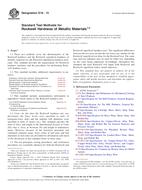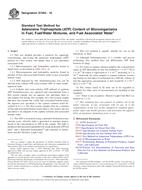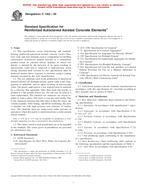1.1 This guide is intended to determine the relative environmental influence of new munition constituents, consistent with the research and development (R&D) level of effort and is intended to be applied in a logical, tiered manner that parallels both the available funding and the stage of research, development, testing, and evaluation. Specifically, conservative assumptions, relationships, and models are recommended early in the research stage, and as the munition technology is matured, empirical data will be developed and used. Munition constituents may include fuels, oxidizers, explosives, binders, stabilizers, metals, dyes, and other compounds used in the formulation to produce a desired effect. Munition systems range from projectiles, grenades, rockets/missiles, training simulators, smokes and obscurants. Given the complexity of issues involved in the assessment of environmental fate and effects and the diversity of the munition systems used, this guide is broad in scope and not intended to address every factor that may be important in an environmental context. Rather, it is intended to reduce uncertainty at minimal cost by considering the most important factors related to the environmental impacts of energetic materials. This guide provides a method for collecting data useful in a relative ranking procedure to provide the munition scientist with a sound basis for prospectively determining a selection of candidates based on environmental and human health criteria.
1.2 The scope of this guide includes:
1.2.1 Energetic materials and compositions in all stages of research, development, test and evaluation.
1.2.2 Environmental assessment, including:
1.2.2.1 Human and ecological effects of the unexploded energetics and compositions on the environment.
1.2.2.2 Environmental transport mechanisms of the unexploded energetics and composition.
1.2.2.3 Degradation and bioaccumulation properties.
1.2.3 Occupational health impacts from manufacture and use of the energetic substances and compositions to include load, assembly, and packing of the related munitions.
1.3 Given the wide array of applications, the methods in this guide are not prescriptive. They are intended to provide flexible, general methods that can be used to evaluate factors important in determining environmental consequences from use of the energetic substances.
1.4 Factors that affect the health of humans as well as the environment are considered early in the development process. Since some of these data are valuable in determining health effects from generalized exposure, effects from occupational exposures are also included.
1.5 This guide does not address all processes and factors important to the fate, transport, and potential for effects in every system. It is intended to be balanced effort between scientific and practical means to evaluate the relative environmental effects of munition compounds resulting from intended use. It is the responsibility of the user to assess data quality as well as sufficiently characterize the scope and magnitude of uncertainty associated with any application of this standard.
1.6 This standard does not purport to address all of the safety concerns, if any, associated with its use. It is the responsibility of the user of this standard to establish appropriate safety and health practices and determine the applicability of regulatory limitations prior to use.
Product Details
- Published:
- 05/01/2008
- Number of Pages:
- 8
- File Size:
- 1 file , 120 KB


